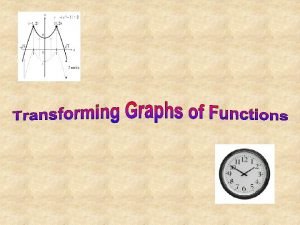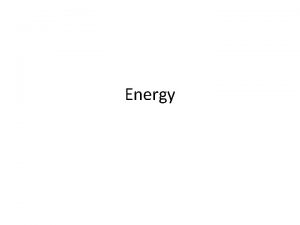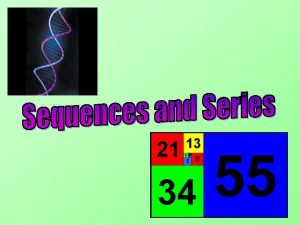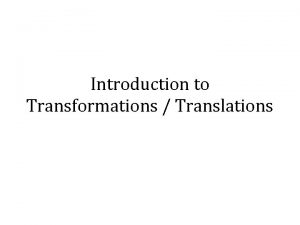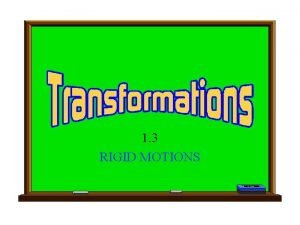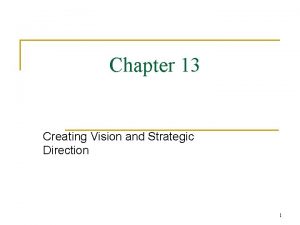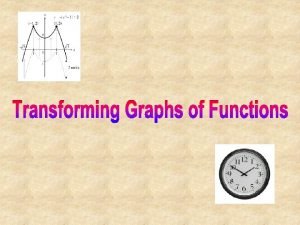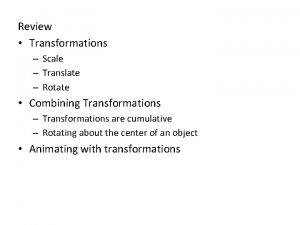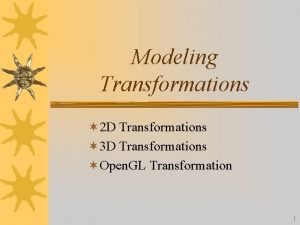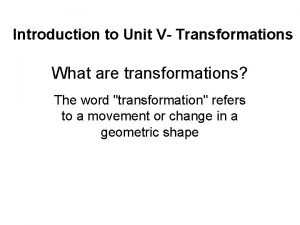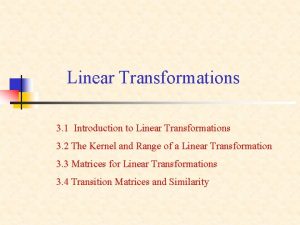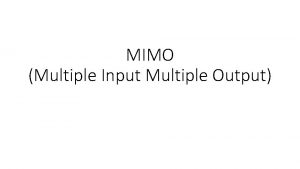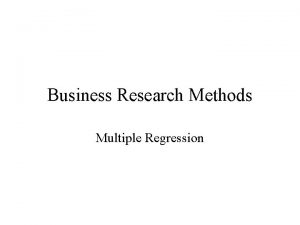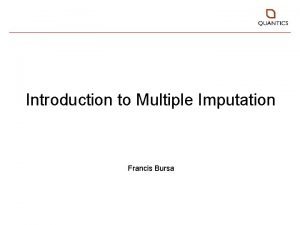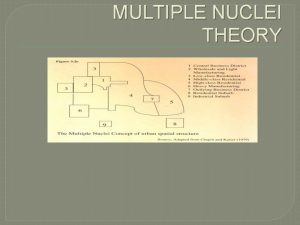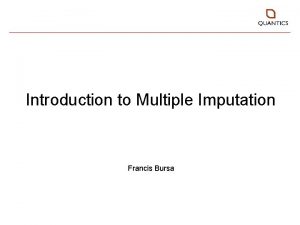Introduction This chapter focuses on multiple transformations of




























- Slides: 28


Introduction • This chapter focuses on multiple transformations of graphs • It will introduce a new concept, ‘modulus’ • We will also look at how to solve equations involving this…


Transforming Graphs of Functions You need to be able to sketch the graph of the modulus function y = |f(x)| The modulus of a number is its positive numerical value. It is written like this: Sketch the graph of: y=x 1) Sketch the graph ignoring the modulus So you can effectively think of a modulus as swapping all negative values to positive ones… y = |x| 2) Reflect the negative part in the x-axis 5 A

Transforming Graphs of Functions You need to be able to sketch the graph of the modulus function y = |f(x)| The modulus of a number is its positive numerical value. It is written like this: Sketch the graph of: y = 3 x - 2 1) Sketch the graph ignoring the modulus -2 2/ So you can effectively think of a modulus as swapping all negative values to positive ones… 3 y = |3 x - 2| 2) Reflect the negative part in the x-axis When the modulus is applied to the whole equation, we are changing the output (y-values), hence the reflection in the x-axis… 2 2/ 3 5 A

Transforming Graphs of Functions You need to be able to sketch the graph of the modulus function y = |f(x)| The modulus of a number is its positive numerical value. It is written like this: Sketch the graph of: y = x 2 – 3 x - 10 1) Sketch the graph ignoring the modulus -2 5 -10 So you can effectively think of a modulus as swapping all negative values to positive ones… y = |x 2 – 3 x - 10| 2) Reflect the negative part in the x-axis 10 -2 5 5 A

Transforming Graphs of Functions You need to be able to sketch the graph of the modulus function y = |f(x)| The modulus of a number is its positive numerical value. It is written like this: Sketch the graph of: 1) Sketch the graph ignoring the modulus 0 y = sinx π/ 2 π So you can effectively think of a modulus as swapping all negative values to positive ones… 3π/ 2 2π y = |sinx| 2) Reflect the negative part in the x-axis 0 π/ 2 π 3π/ 2 2π 5 A


Transforming Graphs of Functions You need to be able to sketch the graph of the modulus function y = f(|x|) The difference here is that we are changing the value of the inputs (x) We are not going to put any negative values into the function Sketch the graph of: y = |x| - 2 1) Sketch the graph for x ≥ 0, ignoring the modulus… 2) Reflect the graph in the yaxis -2 2 -2 The result is that the value we get at x = -3 will be the same as at x = 3 The graph will be reflected in the y-axis… 5 B

Transforming Graphs of Functions You need to be able to sketch the graph of the modulus function y = f(|x|) The difference here is that we are changing the value of the inputs (x) We are not going to put any negative values into the function Sketch the graph of: 1) Sketch the graph for x ≥ 0, ignoring the modulus… -2 2 2) Reflect the graph in the yaxis y =4|x| - |x|3 The result is that the value we get at x = -3 will be the same as at x = 3 The graph will be reflected in the y-axis… 5 B


Transforming Graphs of Functions Solve the Equation: You need to be able to solve equations involving a modulus Solutions to these equations are the places where the two graphs cross (if each side of the equation is plotted as a graph) 1) Draw both graphs, ignoring the modulus part. Work out key points if possible 3 y=3 3/ 4 -3/2 You must pay careful attention to where they cross, on the original graph or the reflected part Try to keep sketches reasonably accurate by working out key points… y = 2 x – 3/2 y = |2 x – 3/2| 2) Alter the graphs to take into account any modulus effects 3 y=3 3/ 2 3/ 4 5 C

Transforming Graphs of Functions Solve the Equation: You need to be able to solve equations involving a modulus Solutions to these equations are the places where the two graphs cross (if each side of the equation is plotted as a graph) You must pay careful attention to where they cross, on the original graph or the reflected part 3) If a solution is on the reflected part, use –f(x) For example point A is on the original blue line, but the reflected red line… Solution A y = |2 x – 3/2| A B 3 y=3 3/ 2 3/ 4 Solution B Try to keep sketches reasonably accurate by working out key points… Using –f(x) for the equation of the red line Solution B is on both original curves, so no modification needed… 5 C

Transforming Graphs of Functions y = |5 x – 2| y = |2 x| You need to be able to solve equations involving a modulus Solve the Equation: 2) Alter the graphs to take into account any modulus effects 2 0 2/ 5 A B Solution A (Reflected Red, Original Blue) y = 5 x – 2 1) Draw both graphs, ignoring the modulus part. Work out key points if possible 0 2/ 5 -2 y = 2 x 3) If a solution is on the reflected part, use –f(x) Solution B (Original Red, Original Blue) 5 C

Transforming Graphs of Functions y = |x 2 – 2 x| You need to be able to solve equations involving a modulus Solve the Equation: 2) Alter the graphs to take into account any modulus effects 0 1/ 8 A 2 y = 1/4 - 2 x Solution A (Original Red, Original Blue) y = x 2 – 2 x 1) Draw both graphs, ignoring the modulus part. Work out key points if possible 1/ 8 0 2 3) If a solution is on the reflected part, use –f(x) or y = 1/4 - 2 x x < 0 at point A so the second solution is the correct one 5 C

Transforming Graphs of Functions y = |x 2 – 2 x| You need to be able to solve equations involving a modulus Solve the Equation: 2) Alter the graphs to take into account any modulus effects B 0 1/ 8 2 y = 1/4 - 2 x Solution B (Reflected Red, Original Blue) y = x 2 – 2 x 1) Draw both graphs, ignoring the modulus part. Work out key points if possible 1/ 8 0 2 y = 1/4 - 2 x 3) If a solution is on the reflected part, use –f(x) or x < 2 at point B so the second solution is the correct one 5 C


Transforming Graphs of Functions You need to be able to apply multiple transformations to the same curve f(x + a) is a horizontal translation of –a units f(x) + a is a vertical translation of a units f(ax) is a horizontal stretch of scale factor 1/a af(x) is a vertical stretch of scale factor a -f(x) is a reflection in the x-axis f(-x) is a reflection in the y-axis 5 D

Transforming Graphs of Functions y = (x – 2)2 + 3 2 y = x 2 y = (x – 2) You need to be able to apply multiple transformations to the same curve Sketch the graph of: 7 Build the equation up from y = x 2 Horizontal Translation, 2 units right Vertical Translation, 3 units up y-intercept where x=0 5 D

Transforming Graphs of Functions You need to be able to apply multiple transformations to the same curve y = 2/x + 5 y = 1/x 2/ 5 Sketch the graph of: Build the equation up from y = 1/x Horizontal Translation, 5 units left Vertical stretch, scale factor 2 At the yintercept, x = 0 5 D

Transforming Graphs of Functions You need to be able to apply multiple transformations to the same curve 2 Sketch the graph of: 1 0 Build the equation up from y = cosx 90 180 270 360 -1 -2 Horizontal ‘stretch’, scale factor 1/2 y = cos 2 x - 1 Vertical translation 1 unit down 5 D

Transforming Graphs of Functions You need to be able to apply multiple transformations to the same curve y = 3|x – 1| y=x-1 3 Sketch the graph of: y = |x – 1| 1 1/ 3 Build the equation up from y = x - 1 11 -1 5/ 3 y = 3|x – 1| - 2 Reflect negative values in the x-axis Vertical stretch, scale factor 3 Vertical translation 2 units down You will need to do more than one sketch for these – do not do lots on the same diagram! 5 D


Transforming Graphs of Functions B(6, 8) B(6, 7) When you are given a sketch of y = f(x), you need to be able to sketch transformations and show the final position of original co-ordinates To the right is the graph of y = f(x) B(6, 4) O O(0, -1) A(2, -2) A(2, -3) Sketch the graph of: y = 2 f(x) – 1 and state the new coordinates of O, A and B… y = f(x) y = 2 f(x) - 1 Vertical Stretch, scale factor 2 y-values double Vertical translation 1 unit down y-values reduced by 1 5 E

Transforming Graphs of Functions y = f(x + 2) + 2 When you are given a sketch of y = f(x), you need to be able to sketch transformations and show the final position of original co-ordinates B(4, 6) B(4, 4) A(0, 1) O(-2, 2) O(-2, 0) O A(0, -1) To the right is the graph of y = f(x) B(6, 4) A(2, -1) y = f(x + 2) Sketch the graph of: y = f(x + 2) + 2 and state the new coordinates of O, A and B… Horizontal translation 2 units left x-values reduced by 2 Vertical translation 2 units up y-values increased by 2 5 E

Transforming Graphs of Functions When you are given a sketch of y = f(x), you need to be able to sketch transformations and show the final position of original co-ordinates To the right is the graph of y = f(x) y = 1/4 f(2 x) B(3, 4) B(6, 4) B(3, 1) A(1, -0. 25) O A(1, -1) A(2, -1) y = f(x) y = f(2 x) Sketch the graph of: y = 1/4 f(2 x) and state the new coordinates of O, A and B… Horizontal stretch, scale factor 1/2 x-values divided by 2 Vertical stretch, scale factor 1/4 y-values divided by 4 5 E

Transforming Graphs of Functions y = f(x - 1) When you are given a sketch of y = f(x), you need to be able to sketch transformations and show the final position of original co-ordinates B(6, 4) O(1, 0) B(7, 4) A(3, 1) O A(2, -1) A(3, -1) To the right is the graph of y = f(x) B(7, -4) Sketch the graph of: y = -f(x - 1) and state the new coordinates of O, A and B… Horizontal translation 1 unit right x-values increase by 1 Reflection in the x-axis y-values ‘swap sign’ (times -1) 5 E

Summary • We have learnt about modulus graphs • We have seen how sketches help us solve equations involving a modulus • We have also practised multiple transformations and tracked given coordinates
 Multiple transformations geometry
Multiple transformations geometry Multiple transformations occur when
Multiple transformations occur when Conservation and transformation of energy
Conservation and transformation of energy This chapter focuses on
This chapter focuses on Pre calc sequences and series
Pre calc sequences and series Baseline
Baseline Multiple instruction single data
Multiple instruction single data Joseph rychlak custom reader
Joseph rychlak custom reader Precosmogonic
Precosmogonic Introduction to transformations
Introduction to transformations Introduction to rigid transformations
Introduction to rigid transformations Appolinian
Appolinian 14line poem
14line poem Psychoanalytic criticism definition
Psychoanalytic criticism definition Developing a firm's strategy canvas focuses on
Developing a firm's strategy canvas focuses on Class list log examples
Class list log examples Management spectrum includes
Management spectrum includes Surrealism focuses on
Surrealism focuses on Sociology of physical activity focuses on
Sociology of physical activity focuses on Class list log observation
Class list log observation Vision focuses on the current reality and maintaining it
Vision focuses on the current reality and maintaining it Behaviorism focuses on
Behaviorism focuses on Mcdp 1 states that trust between marines
Mcdp 1 states that trust between marines Different lenses in literature
Different lenses in literature Diverse information sharing through universal web access.
Diverse information sharing through universal web access. Authentic leadership focuses on
Authentic leadership focuses on Developing a firms strategy canvas focuses on
Developing a firms strategy canvas focuses on Identify synoynm
Identify synoynm Management focuses on
Management focuses on
